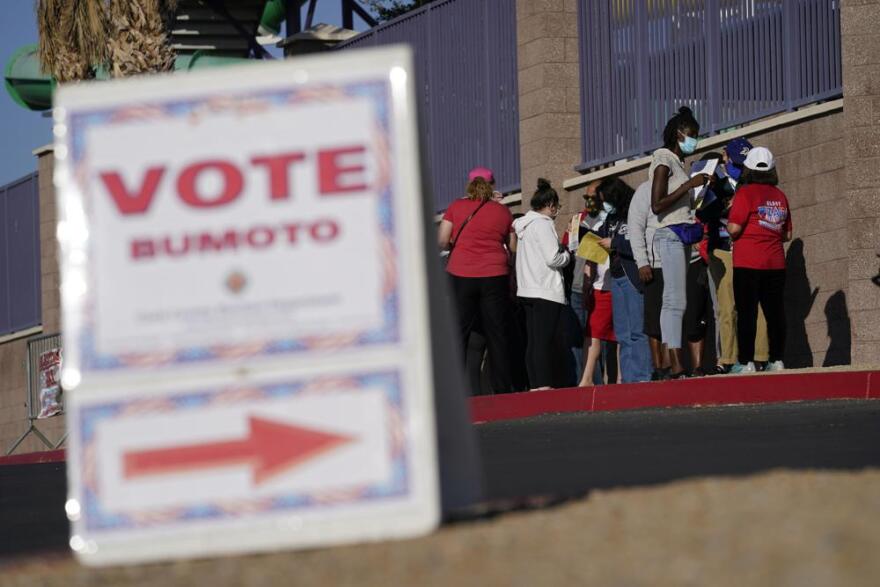Limiting the size of new swimming pools in and around Las Vegas might save a drop in the proverbial bucket amid historic drought and climate change in the West.
Officials are taking the plunge anyway, capping the size of new swimming pools at single-family residential homes to about the size of a three-car garage.
Citing worries about dwindling drinking water allocations from the drying-up Lake Mead reservoir on the depleted Colorado River, officials in Clark County voted this week to limit the size of new swimming pools to 600 square feet of surface area.
“Having a pool in Las Vegas is like having a second car. It’s that common,” said Kevin Kraft, owner of a family custom pool design company that has been in business since 1942.
Clark County figures show there are about 200,000 residential swimming pools in the area of 2.4 million people. Another 1,300 are added annually.
“When you’re in the desert and it’s 100 degrees outside on a regular basis, it’s part of life to have a pool,” said Kraft, who derided the new regulations as more about “optics” than saving water.
But Clark County Commission Chairman Jim Gibson lamented before voting in favor of the cap Tuesday: “If the trends continue and the lake continues to decline, then this may be one of the least of the tough decisions that we’ll be making over the course of time.”
On Thursday, the Southern Nevada Water Authority voted unanimously to send the restriction to a vote by city councils in neighboring North Las Vegas and Henderson. Authority officials and an industry trade group, the Pool & Hot Tub Alliance, said they think the Las Vegas-area restriction is a first in the U.S.
The estimated 3,000 glimmering “commercial” pools familiar to the 40 million tourists who visit Las Vegas resort hotels, motels and water parks annually, or live in apartments, will not be affected by the limit.
Water use, abuse and scarcity have been hot topics during the scorching summer of 2022. Temperatures are projected to top 110 degrees Fahrenheit this week in Las Vegas, which averages a little more than 4 inches of rainfall per year.
Television ads urging water conservation are as common as theories about the history behind sunken boats and bodies that have surfaced in the mud as the crucial Lake Mead reservoir behind Hoover Dam recedes.
The lake providing about 90% of the Las Vegas water supply bears a telltale white mineral bathtub ring on steep lakeside cliffs showing the water line has dropped more than 170 feet since the reservoir was last full in 1983. It’s now below 30% capacity, raising the possibility it could fall so low that Hoover Dam could be unable to generate hydropower or release water downstream.
The Colorado River provides water for millions of acres of irrigation and more than 40 million people in tribes and cities in Arizona, Nevada, New Mexico, Colorado, California, Wyoming, Utah and Mexico.
In the face of that, the penalty for building a pool bigger than allowed after Sept. 1 will be severe: Denial of water service.
Builders of big swimming pools and spas for custom homes in far-flung neighborhoods complained the cap could cripple their companies, and that lap pools and diving boards may become a thing of the past.
“It’s easy to show pictures of lavish swimming pools and say, ‘That’s the problem why we have less water,’” Dustin Watters, whose family business, Watters Aquatech, started installing pools in 1985, told lawmakers Tuesday.
The water authority general manager, John Entsminger, said 23,000 gallons evaporate annually from the average 470 square foot Southern Nevada home swimming pool. About 75% of recently constructed pools were already under the proposed size limit, he said.
The authority projects the pool size restriction will save 3.2 million gallons of water the first year, increasing to 32 million gallons by 2032, still just a fraction of the nearly 91 billion gallons the region draws from the lake per year.
Kraft and others in the pool industry told lawmakers the estimated savings under the pool size cap of one-tenth of a gallon per person per day was insignificant. The water authority could impose fees on owners of large pools, he suggested, and use the money to hire more water restriction enforcement agents.
The authority estimates that “enhanced watering compliance” could save 5.7 gallons (21.6 liters) per person per day. But water authority board member Cedric Crear, a Las Vegas City Council member, said “the philosophy that you can pay your way out of it is not a sound strategy.”
The vote to limit home pool sizes is the latest step by the authority to promote robust water reuse and conservation. It already encourages the removal of front lawns, and in recent months expanded patrols to identify and fine violators of landscape watering restrictions.
A new Nevada law that takes effect in 2027 bans “non-functional” or ornamental greenery at office parks, in street medians and entrances to housing developments. It excludes single-family homes, parks and golf courses.
Those measures put Southern Nevada years ahead of places like Los Angeles, where the regional water supplier declared a water emergency in April and imposed a one-day-per-week outdoor watering schedule for 6 million customers.
In Arizona, irrigation districts, water agencies, state entities and cities including Phoenix, Glendale, Scottsdale and Tempe have said they’ll find ways to use less water.
Kraft, the owner of the pool design company, said Las Vegas-area officials didn’t fully consider a study commissioned by the pool industry or other business recommendations. He predicted that multimillion-dollar home projects will be delayed or scrapped because of the new rule.
“The tone we got was that rich people shouldn’t be able to have big pools,” Kraft told The Associated Press. “All this work that people do on these big custom homes is usually around the pool. The pool is a big part of the design of the project.”








